February 2017 lunar eclipse
A penumbral lunar eclipse took place at the Moon’s ascending node on February 11, 2017, the first of two lunar eclipses in 2017. It was not quite a total penumbral lunar eclipse. It occurred the same day as comet 45P/Honda–Mrkos–Pajdušáková made a close approach to Earth (0.08318 AU). It also occurred on the Lantern Festival, the first since February 9, 2009. Occurring only 4.4 days after perigee (Perigee on February 6, 2017), the moon's apparent diameter was larger.
| Penumbral eclipse | |||||||||
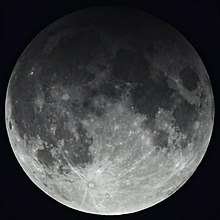 From Rabka-Zdrój, Poland, 00:51 UTC | |||||||||
| Date | 11 February 2017 | ||||||||
|---|---|---|---|---|---|---|---|---|---|
| Gamma | -1.0254 | ||||||||
| Magnitude | 0.9884 | ||||||||
| Saros cycle | 114 (59 of 71) | ||||||||
| Penumbral | 259 minutes, 10 seconds | ||||||||
| |||||||||
The tables below contain detailed predictions and additional information on the Penumbral Lunar Eclipse of 11 February 2017.
Eclipse Characteristics
Date = 11 February 2017
Penumbral Magnitude = 0.98838
Umbral Magnitude = -0.03539
Gamma = -1.02548
Epsilon = 0 degrees, 59 minutes, 34.08 seconds
Saros Series: 114th (59 of 71)
Opposition Times
Greatest Eclipse = 11 Feb 2017 00:43:54.2 UTC (00:45:02.5 TD)
Ecliptic Opposition = 11 Feb 2017 00:32:53.0 UTC (00:34:01.3 TD)
Equatorial Opposition = 11 Feb 2017 01:10:40.9 UTC (01:11:49.2 TD)
Geocentric Coordinates of Sun and Moon
Sun right ascension = 21.66
Moon right ascension = 9.64
Earth's shadow right ascension = 9.66
Sun declination = -14
Moon declination = 13.05
Earth's shadow declination = 14
Sun diameter = 1944.6 arcseconds
Moon diameter: 1899.6 arcseconds
Geocentric Libration of the Moon
Latitude = 4.8 degrees north
Longitude = 1.3 degrees east
Direction = 20.4 (NNE)
Earth's Shadows
Penumbral Diameter = 9003.6 arcseconds
Moon Diameter = 5114.16 arcseconds
Times
Penumbral Begins = 10 Feb 2017 22:34:14.1 UTC
Greatest Eclipse = 11 Feb 2017 00:43:54.2 UTC
Penumbral Ends = 11 Feb 2017 02:53:29.0 UTC
Visibility
It was visible from the Americas, Europe, Africa, and most of Asia.
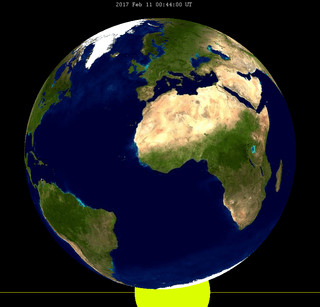 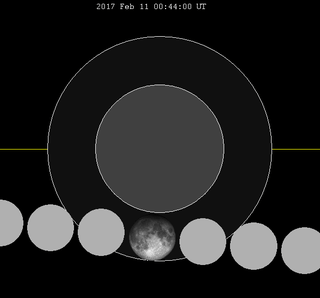 View of earth from moon during greatest eclipse |
 Visibility map |
Gallery
.jpg) Time lapse images from Melbourne, FL
Time lapse images from Melbourne, FL.jpg) Kissimmee, FL, 0:00 UTC
Kissimmee, FL, 0:00 UTC.jpg) Tampa, FL, 0:11 UTC
Tampa, FL, 0:11 UTC.jpg) New York City, NY, 0:23 UTC
New York City, NY, 0:23 UTC.jpg) Naperville, IL, 1:23 UTC
Naperville, IL, 1:23 UTC
Related eclipses
Eclipses of 2017
Lunar year series
| Lunar eclipse series sets from 2016–2020 | ||||||||
|---|---|---|---|---|---|---|---|---|
| Descending node | Ascending node | |||||||
| Saros | Date | Type Viewing |
Gamma | Saros | Date Viewing |
Type Chart |
Gamma | |
| 109 | 2016 Aug 18 |
Penumbral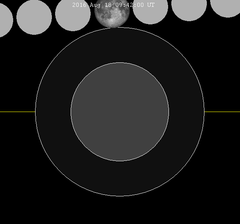 |
1.5641 | 114 |
2017 Feb 11 |
Penumbral |
-1.0255 | |
119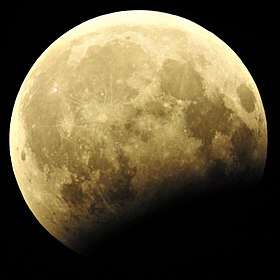 |
2017 Aug 07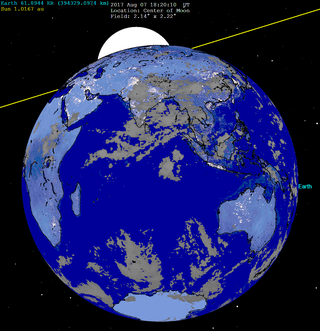 |
Partial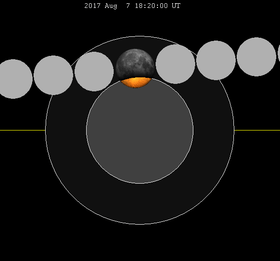 |
0.8669 | 124 |
2018 Jan 31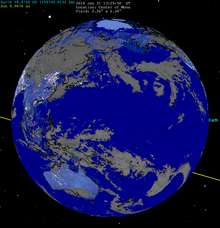 |
Total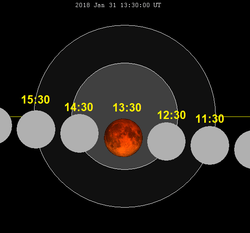 |
-0.3014 | |
129_(43696968392)_(cropped).jpg) |
2018 Jul 27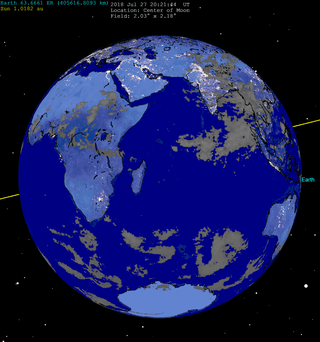 |
Total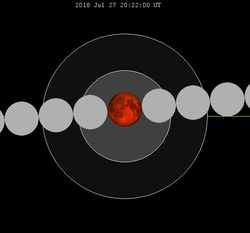 |
0.1168 | 134_(cropped).jpg) |
2019 Jan 21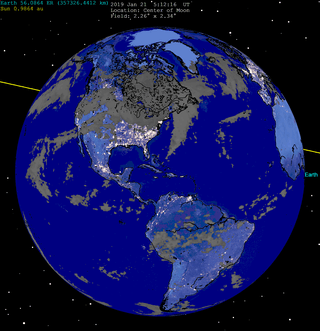 |
Total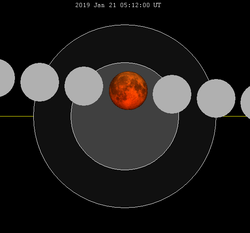 |
0.3684 | |
139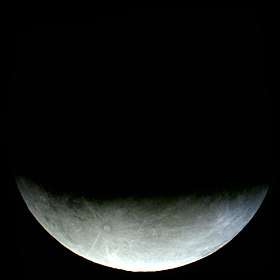 |
2019 Jul 16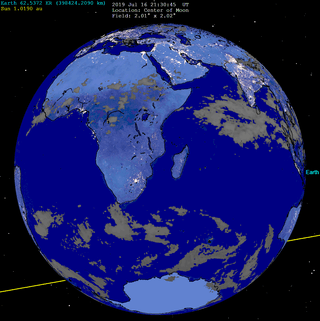 |
Partial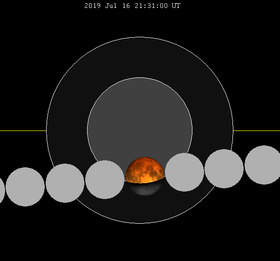 |
-0.6430 | 144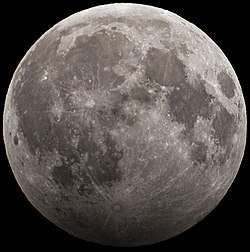 |
2020 Jan 10 |
Penumbral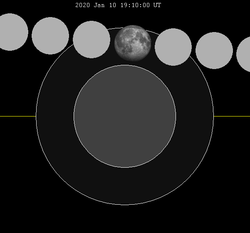 |
1.2406 | |
| 149 | 2020 Jul 05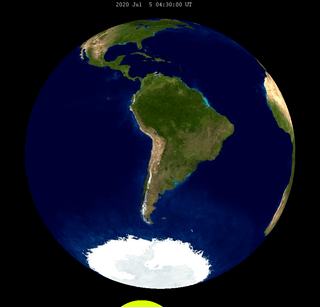 |
Penumbral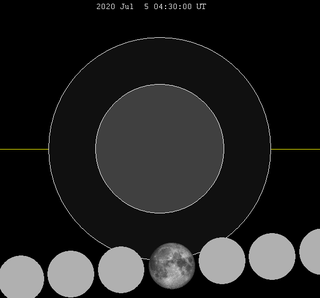 |
-1.3639 | |||||
| Last set | 2016 Sep 16 | Last set | 2016 Mar 23 | |||||
| Next set | 2020 Jun 05 | Next set | 2020 Nov 30 | |||||
Saros series
It is part of Saros cycle 114.
Lunar Saros series 114, repeating every 18 years and 11 days, has a total of 71 lunar eclipse events including 13 total lunar eclipses.
First Penumbral Lunar Eclipse: 0971 May 13
First Partial Lunar Eclipse: 1115 Aug 07
First Total Lunar Eclipse: 1458 Feb 28
First Central Lunar Eclipse: 1530 Apr 12
Greatest Eclipse of Lunar Saros 114: 1584 May 24
Last Central Lunar Eclipse: 1638 Jun 26
Last Total Lunar Eclipse: 1674 Jul 17
Last Partial Lunar Eclipse: 1890 Nov 26
Last Penumbral Lunar Eclipse: 2233 Jun 22
Half-Saros cycle
A lunar eclipse will be preceded and followed by solar eclipses by 9 years and 5.5 days (a half saros).[1] This lunar eclipse is related to two annular solar eclipses of Solar Saros 121.
| February 7, 2008 | February 17, 2026 |
|---|---|
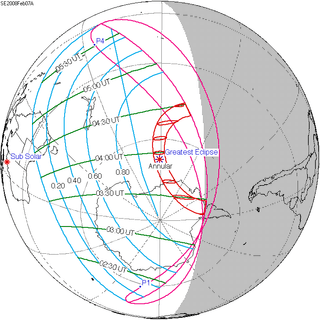 |
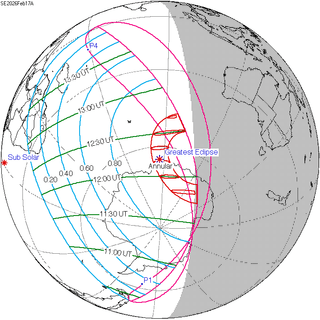 |
See also
- List of lunar eclipses and List of 21st-century lunar eclipses
References
- Mathematical Astronomy Morsels, Jean Meeus, p.110, Chapter 18, The half-saros
External links
| Wikimedia Commons has media related to Lunar eclipse of 2017 February 11. |
- 2017 Feb 11 chart: Eclipse Predictions by Fred Espenak, NASA/GSFC
- 11 Feb 2017 - Penumbral Lunar Eclipse - Penumbral Lunar Eclipse
- Pakistan to witness lunar eclipse on February 11
